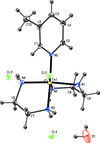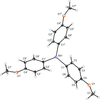issue contents
July 2018 issue

Cover illustration: The C3-symmetrical molecule, tris(4-methoxyphenyl)stibine exhibits perfect C3-symmetry with one third of the molecule in the asymmetric unit. This compound is observed regularly as a side product in the synthesis of asymmetric sulfides. This report of its structure fills the gap in the row of homologues of the type C21H21O3E, with E being an element of group 14. In the crystal, two molecules are connected by six weak C-H
![[pi]](/logos/entities/pi_rmgif.gif) interactions, forming discrete dimeric units with the antimony atom facing outwards. See: Böhm, Golz & Alcarazo, [IUCrData (2017). 3, x180989].
interactions, forming discrete dimeric units with the antimony atom facing outwards. See: Böhm, Golz & Alcarazo, [IUCrData (2017). 3, x180989].
metal-organic compounds


 access
access

 access
access

 access
accessorganic compounds


 access
access

 access
access

 access
access

 access
access

 access
access

 access
access

 access
access

 access
access

 access
access

 access
access

 access
access

 journal menu
journal menu

























![[publCIF]](/logos/authorchecklist11.gif)





